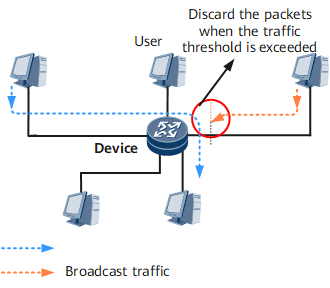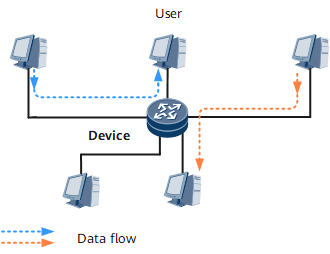Traffic Suppression Fundamentals
Traffic Types
Traffic in a Layer 2 network is classified into the following types:
Unicast traffic: For the unicast packets that have destination MAC mapping entries in the MAC table, the NetEngine 8000 F forwards them based on the mapping entries.
Unknown unicast traffic: For the unicast packets that have no destination MAC mapping entries in the MAC table, the NetEngine 8000 F broadcasts them.
Multicast traffic: For the packets whose destination MAC addresses are multicast MAC addresses, the NetEngine 8000 F broadcasts them.
Broadcast traffic: For the packets whose destination MAC addresses are broadcast MAC addresses, the NetEngine 8000 F broadcasts them.
To ensure normal forwarding of unicast traffic, you can limit the bandwidth for forwarding the unknown unicast traffic, multicast traffic, and broadcast traffic by configuring traffic suppression on the NetEngine 8000 F.
Background of Traffic Suppression
To improve the communication efficiency of traditional LANs and allow more PCs to access the LAN, as well as avoiding conflicts on the network, a Layer 2 device is deployed. Through MAC address learning, a Layer 2 device restricts the conflicts on the shared link to each attached interface. Figure 1 shows a typical networking diagram of traffic suppression on the NetEngine 8000 F.

In this scenario, the NetEngine 8000 F is used as a Layer 2 device.
The NetEngine 8000 F receives all the data frames across the network. It learns the source MAC address carried in the frames and constructs a MAC address table to store the mapping between the MAC address and the source interface.
After receiving a data frame, the NetEngine 8000 F searches the MAC address table for its mapping destination MAC address. If the corresponding MAC address is found, the NetEngine 8000 F forwards the frame to the destination MAC. In this manner, the NetEngine 8000 F implements conflict isolation. Otherwise, the NetEngine 8000 F broadcasts the frame to all the interfaces except the interface that sends the frame. Broadcast storms then occur across the network.
When receiving a multicast or broadcast packet, the NetEngine 8000 F cannot exactly find the interface for which the packet destines based on the destination MAC address. The NetEngine 8000 F then also needs to forward the multicast or broadcast packet to all the interfaces except the interface that sends the packet. In such a case, broadcast storms are also generated.
Deploying NetEngine 8000 F in the network can improve the unicast forwarding efficiency. The broadcast traffic, however, degrades the NetEngine 8000 F performance. To solve this problem, traffic suppression is introduced.
Traffic Suppression
If the broadcast traffic is not suppressed, a great amount of network bandwidth is consumed when a great deal of broadcast traffic flows through the network. The network performance is thus degraded, even interrupting the communication.
In such a case, configure broadcast traffic suppression on the NetEngine 8000 F to ensure that the device can reserve specific bandwidth for forwarding unicast traffic when broadcast traffic bursts across the network.

